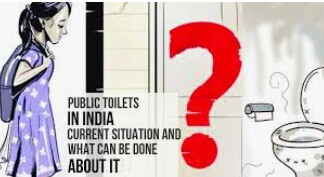Nearly half of India’s population have no toilet at home, but more people own a mobile phone. According to available data only 46.9% households have lavatories while 49.8% defecate in open. The remaining 3.2% use public toilets.Providing accessible toilets can validate, reinforce and celebrate public culture and our shared ‘right to the city’. The world bank links one in ten deaths in India to poor sanitation.The Indian public toilet system has been subject to a lot of criticism. Even the cinema has played its part in highlighting its sorry state of affairs and the people’s plight, especially in the rural and semi-urban areas. Disgusting, dirty, sloppy, these are usual adjectives that strikes us when we think of the Indian public sanitation.We all may have been, at some point, compelled to witness this first hand, and we must have made a promise to ourselves that we would not put our bodies through unhygienic and appalling experience ever again, right?
The world bank links one in ten deaths in India to poor sanitation.The Indian public toilet system has been subject to a lot of criticism. Even the cinema has played its part in highlighting its sorry state of affairs and the people’s plight, especially in the rural and semi-urban areas. Disgusting, dirty, sloppy, these are usual adjectives that strikes us when we think of the Indian public sanitation.We all may have been, at some point, compelled to witness this first hand, and we must have made a promise to ourselves that we would not put our bodies through unhygienic and appalling experience ever again, right? While public toilets in India for both men and women tend to be untidy and unhygienic, it is distinctly more unhealthy and unsafe for women because of the physical contact required with such facilities.Apart from the lack of standard hygiene practices of the public toilets in India, these facilities continue to be in a poor shape due to low awareness about proper sanitation practices among the people.
While public toilets in India for both men and women tend to be untidy and unhygienic, it is distinctly more unhealthy and unsafe for women because of the physical contact required with such facilities.Apart from the lack of standard hygiene practices of the public toilets in India, these facilities continue to be in a poor shape due to low awareness about proper sanitation practices among the people.  Open defecation has been practised in India for a long time, and it continues to exist to date.
Open defecation has been practised in India for a long time, and it continues to exist to date.
 To provide hygienic sanitation facilities to the general public, Dr. Bindeshwar Pathak initiated the ‘Sulabh Shauchalaya’ movement in 1970. With the aim to end open defecation and provide proper sanitation facilities for both men and women, Dr. Pathak spearheaded the mission to build Sulabh Shauchalaya (Public Toilet) facilities all over the country.While his vision and efforts have been admirable and paved the way for a clean and open defecation free India, a large number of sanitation facilities built under the mission were not maintained properly and degraded fast due to the use of outdated fittings and materials.
To provide hygienic sanitation facilities to the general public, Dr. Bindeshwar Pathak initiated the ‘Sulabh Shauchalaya’ movement in 1970. With the aim to end open defecation and provide proper sanitation facilities for both men and women, Dr. Pathak spearheaded the mission to build Sulabh Shauchalaya (Public Toilet) facilities all over the country.While his vision and efforts have been admirable and paved the way for a clean and open defecation free India, a large number of sanitation facilities built under the mission were not maintained properly and degraded fast due to the use of outdated fittings and materials.
While the Sulabh Shauchalaya was a first step towards providing hygienic sanitation facilities, it could not accomplish its goals completely.
 In October 2014, the Prime Minister of India launched the ‘Swachh Bharat Abhiyan,’ and one of its primary goals was to achieve an open defecation free India.The Swachh Bharat Abhiyan transformed the way Indians see cleanliness and public spaces. Under this mission, several public and household toilets have been installed across the country. According to government claim around 99% population of the country has full access to toilets which seems to far behind the reality. Also currently more than six lakh toilets in rural India have acute water shortage. Where as around 120000 toilets have no water supply and thousands of toilets are completely abandoned, with collapsing roofs, water pipes in poor shape and soggy, broken doors. Again The National Rural Annual Sanitation Survey, Round 3,19-20, that surveys 92010 households, indicates that 94% of households have access to toilet and 95% of individuals use it .However, the ground reality is that open defecation practice continues to exist.
In October 2014, the Prime Minister of India launched the ‘Swachh Bharat Abhiyan,’ and one of its primary goals was to achieve an open defecation free India.The Swachh Bharat Abhiyan transformed the way Indians see cleanliness and public spaces. Under this mission, several public and household toilets have been installed across the country. According to government claim around 99% population of the country has full access to toilets which seems to far behind the reality. Also currently more than six lakh toilets in rural India have acute water shortage. Where as around 120000 toilets have no water supply and thousands of toilets are completely abandoned, with collapsing roofs, water pipes in poor shape and soggy, broken doors. Again The National Rural Annual Sanitation Survey, Round 3,19-20, that surveys 92010 households, indicates that 94% of households have access to toilet and 95% of individuals use it .However, the ground reality is that open defecation practice continues to exist.
A working paper titled ‘Changes in open defecation in rural North India: 2014-2018’ published in January 2019, jointly by policy by Research Institute for Compassionate Economics (RICE) and New-Delhi based Accountability Initiative, presents less than desirable statistics.
 After surveying more than 9500 people and 150 government officials between 2014 – 2018, in states like Madhya Pradesh, Bihar, Uttar Pradesh, and Rajasthan, the paper noted that while more Indian villages had a public toilet in 2018 compared to 2014, but 44% of the people continue to defecate in the open.
After surveying more than 9500 people and 150 government officials between 2014 – 2018, in states like Madhya Pradesh, Bihar, Uttar Pradesh, and Rajasthan, the paper noted that while more Indian villages had a public toilet in 2018 compared to 2014, but 44% of the people continue to defecate in the open.
A sustainable solution to provide a safe and hygienic sanitation facility is to combine good intent with modern technology. Furthermore, there is a massive need to create awareness about the health risks of open defecation practices and run programs to educate the people on how to use the public toilets correctly and maintain hygiene.





